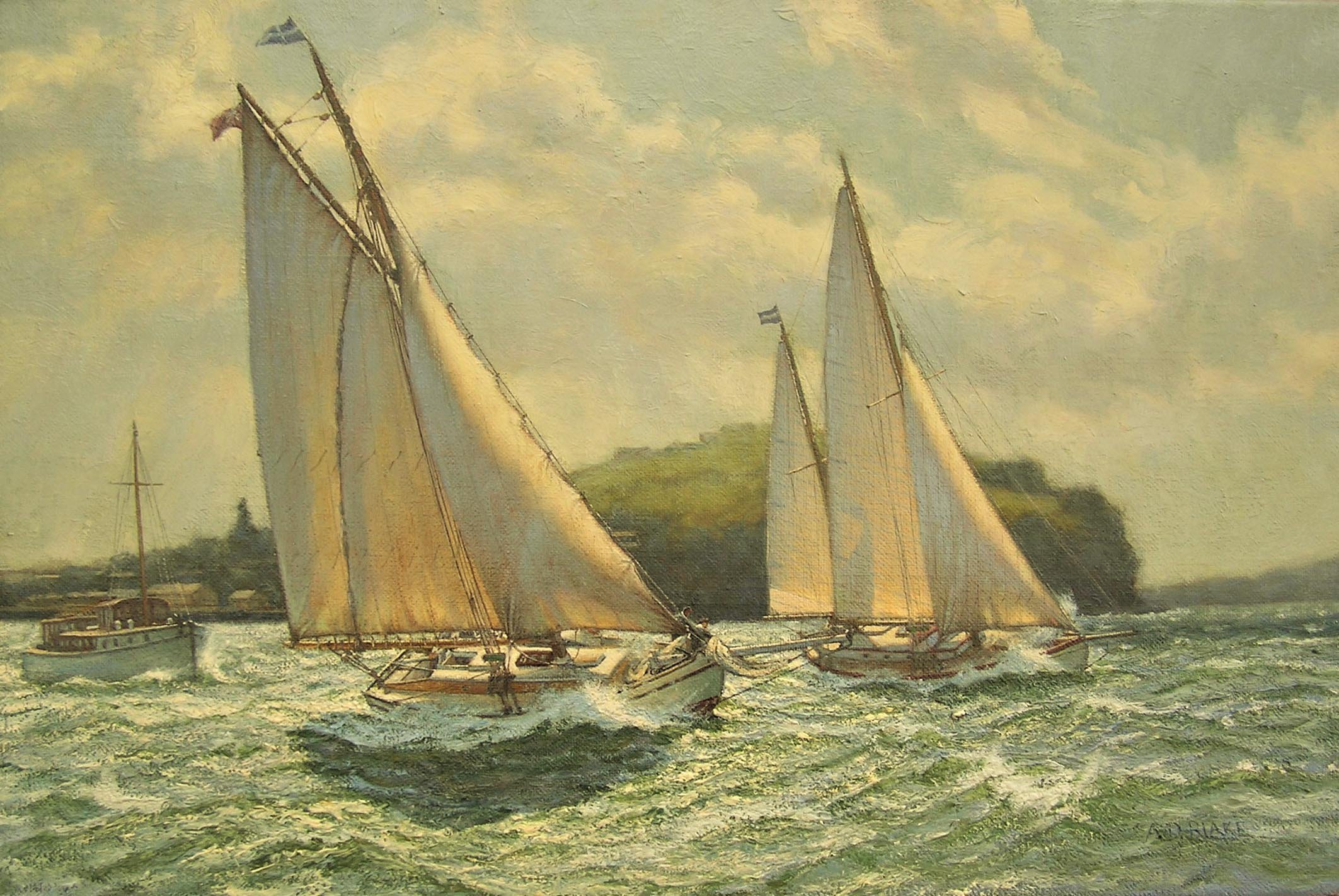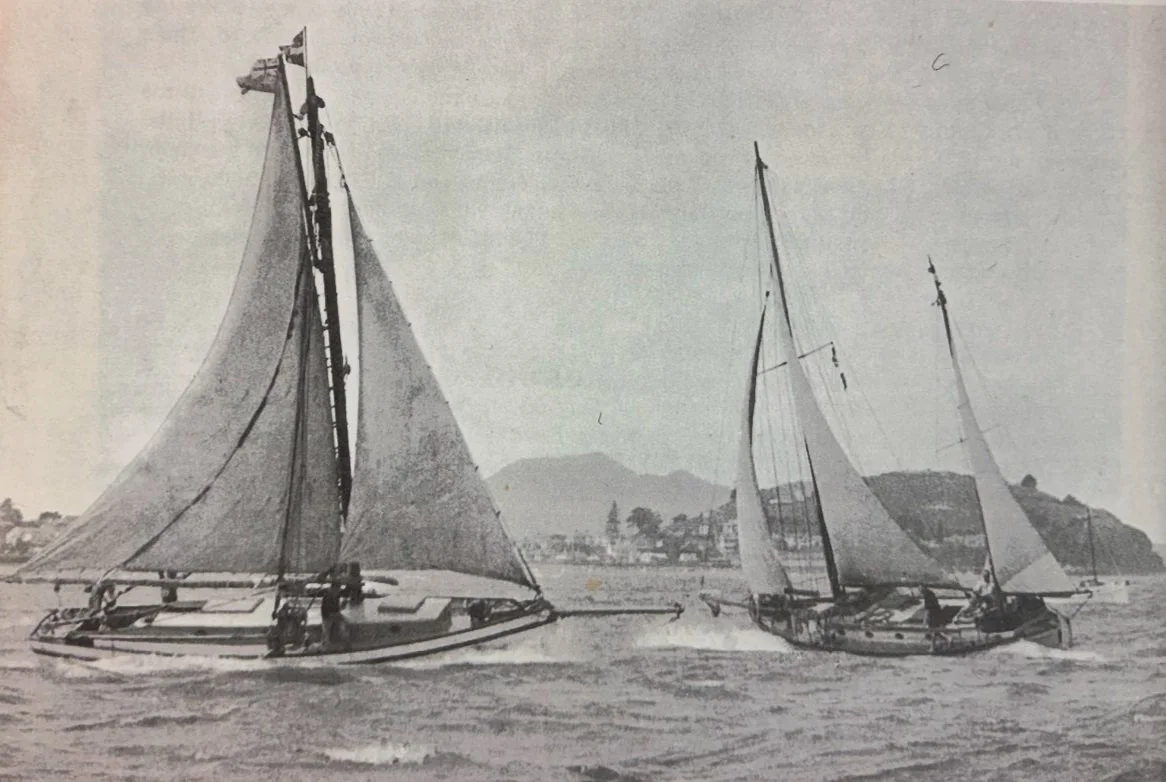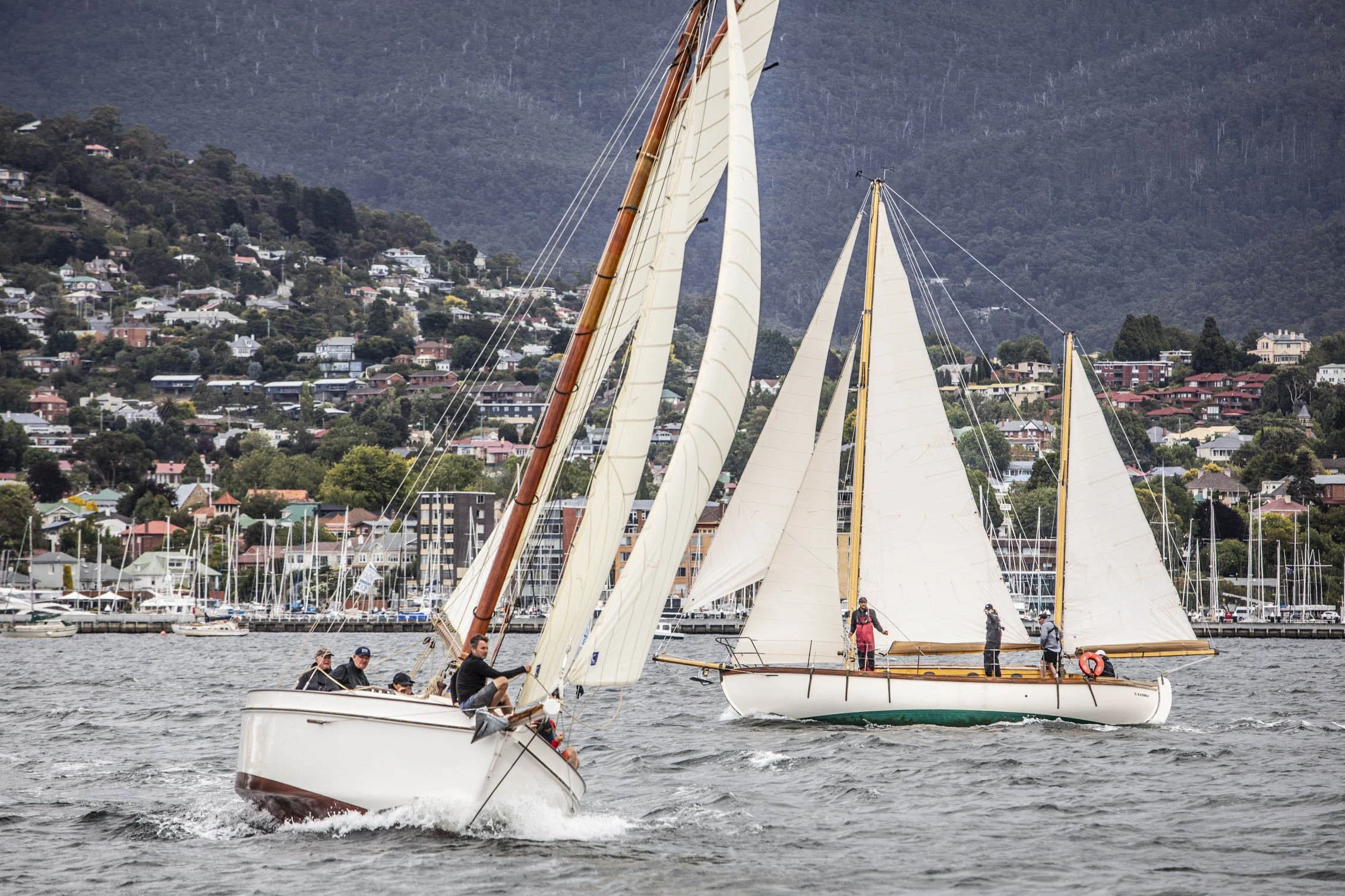Still Making History
AS part of the AWBF, two small boats raced on the Derwent River in Hobart last weekend, after a 90 year break. But they weren’t just any old boats. They are two of the most storied small craft ever to sail in this corner of the Pacific.
December 1934, The Waitemata, Auckland
February 2025, The Derwent, Hobart
Many of you would know of and have read the books “South Sea Vagabonds’ and “Dark Sun” which recount the adventures of Johnny Wray and George Dibbern respectively.
I’m not going to recap these seminal works here, suffice to say that if you like an adventure story, with a little bit of history and romance thrown in, then these two accounts will not disappoint.
The stories run vaguely in parallel through the 1930’s and 40’s, intertwining occasionally. One such occasion was the race that the two yachts engaged in, between Melbourne and Hobart in 1935. After racing across the Tasman from Auckland the previous year, (Te Rapunga won) the crews spent nearly three months in Melbourne enjoying, perhaps to excess, the local hospitality. The skippers decided you could have too much of a good thing and decided to continue the challenge from Melbourne to Hobart. Johnny Wray picks up the story…
My life in the Royal St. Kilda Yacht Club (now Royal Melbourne Yacht Squadron) revolved, I am afraid, mostly around the bar. I had patronized the bar fairly frequently during our stay and the bar was, I thought, a fitting place in which to start this next ocean race. So this was included in the racing rules: The crews of the competing yachts should be assembled at the bar of [the club] on the 23rd [of January]. The starting gun would be fired at 7 p.m. and the crews would consume a schooner of beer (for the benefit of the uninitiated, a “schooner” contains one imperial quart) as rapidly as possible. They would then run down the road and along the wharf and get under way.
Thus at 7 p.m. we were assembled at the bar of the Yacht Club, together with approximately half the population of Melbourne. The day had been spent largely in saying good-bye to our many Melbourne friends and as far as I was concerned, at least, the world had become a grand and wonderful place.
The starting gun was fired from the roof of the Club. Quickly we drained our schooners and said good-bye again. Not without some difficulty I headed my crew from the club. We raced across the road and along the wharf, to where NGATAKI was lying in readiness. The mooring lines were cast off, sails were hoisted and we began to move away from the wharf.
The trip down was arduous to say the least, and NGATAKI took a severe drubbing in Storm Bay, and lost again but the reception both yachts got in Tasmania was magnificent.
Scroll forward about eight-five years to around 2020 and both boats are being restored. TE RAPUNGA now owned by Bruny Island Coastal Retreats is undergoing a full restoration by Denman Marine in Kettering.
And why are Bruny Island Coastal retreates involved? A few words from their website explains.
In a world of growing political polarisation and discord, we also felt that George’s message of global citizenship and his life’s purpose to be a bridge of goodwill, to be of particular pertinence and could do with some amplification. The sea epitomises island life, wooden boats and the tradition of exploration. Seafaring vessels have always been crucial to Bruny Island, connecting it, at times in surprising ways, to a world otherwise so isolated from it. We are fascinated by the hidden histories and local stories that form part of our cultural landscape, especially those that interact harmoniously with the natural environment. In the vein of the early explorers, naturalists and expeditioners, we are setting sail in our little bath tub of a boat on a voyage of discovery, not knowing where the journey will take us or what we will learn.
Meanwhile NGATAKI is being worked on by the Tino Rawa Trust in Auckland. And why did the trust see her as being worth saving. In the words of Harold Kidd. New Zealand Yachting historian
It isn’t hard to make a list of the top three local keel yacht/designer combinations that captured Aucklanders’ imaginations in the decade from 1930 to 1940. Right at the end of the decade you would have to include Lou Tercel and his ultra-modern crack racer RANGER and Jack Brooke with his equally modern C Class keeler GLEAM, and at the beginning there has to be a place for ugly duckling NGATAKI
So someone has an idea… and a seed is sown.
Imagine if one day the two restored vessels could race again on the river where they last competed. It takes visionaries to make things like this happen, and Michelle Khan and Tony Stevenson from the Tino Rawa Trust are just that. With the encouragement and support of Paul Stephanus, director of the AWBF, NGATAKI was packed into her cradle and shipped to Hobart along with a container of other boats and yachting paraphernalia. That sounds easy but it isn’t! There is huge effort, cost and organisation involved. But they pulled it off, and a few days before the Festival her mast was re-stepped and she was readied for an outing against her old foe.
The idea was that the two fully restored boats would go out on the Derwent and sail a short course in company. There would be a start boat to see them on their way, and then they would cruise sedately beside each other providing opportunities for photographs.
Well that wasn’t going to happen! On an overcast day with a 15 knot South Easterly blowing, the fog horn sounded, signalling the start, and it was on for young and old! (click to enlarge)
NGATAKI hit the line first at the eastern end of Sullivan’s Cove. Despite being on the wrong side of a few shifts, the more efficient windward rig of TE RAPUNGA whittled down her lead, so the gaffer only held a three boat length advantage at the first mark.
The journey out to Punchs Reef off Tranmere (the second mark) was also a beat. NGATAKI tried out her bigger headsail, launched off the bowsprit, but couldn’t keep her height and had to drop it. Much flapping and shouting!
TE RAPUNGA reached the windward mark ahead, but once NGATAKI went round and her big gaff main was eased, she shadowed the yawl, and she began to claw back the lead.
As both boats gybed around the final mark off Bellerive, NGATAKI was just ahead, and the new reaching wind angle meant that neither boat had an advantage. Both boats were seeking any leverage they could muster as they lurched down to the finish, TE RAPUNGA closing the gap… inch by inch.
Its at this point that the story becomes unconvincing. Wave after wave drove the boats to the west. Sometimes one gets ahead, then the other. As they passed through the finish line the winner was genuinely unpickable. “RIGGED!” I here you cry. But no… it wasn’t. It was just another memorable chapter being written by the sailing gods, in the history of these two extraordinary craft.
Perhaps the next chapter will be written in on the Waitemta in 2026 at the Auckland Wooden Boat Festival?















